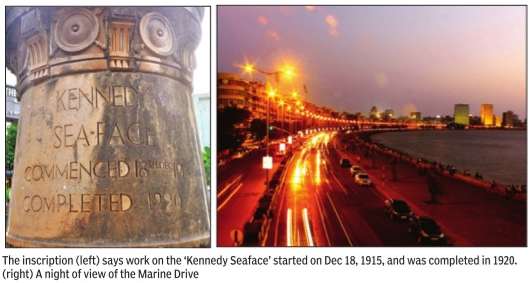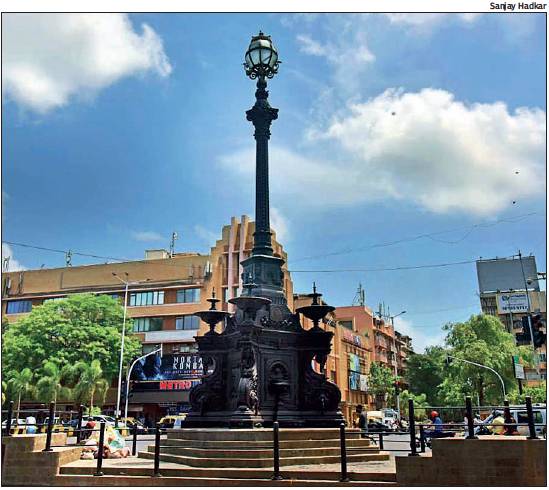Mumbai: M
This is a collection of articles archived for the excellence of their content. |
Contents |
Marine Drive
The Times of India, Nov 08 2015

Nergish Sunavala
Nearing 100, Marine Drive is still Mumbai's heartthrob
In 1969, two starcrossed lovers left their respective homes in Byculla and booked themselves into a Marine Drive hotel. That night, in a desi version of Romeo and Juliet, the two consumed poison and had to be rushed to St George's Hospital in Fort. The girl survived, the boy didn't. That Marine Drive's glittering boulevard was the backdrop for their last act must have added to the drama perhaps the spot even held sentimental value. After all, lovebirds canoodling along the seafront are as much a fixture here as art deco buildings; and numerous Bollywood flicks have been shot along this iconic stretch.
In December 2015, the Marine Drive promenade turns 100, with a stout lamp post near it announcing the upcoming anniversary in stone. “Kennedy Sea-Face commenced 18th December, 1915,“ it reads. “Completed 1920.“
Though reclamation of the stretch was still decades away , this anniversary marks the creation of a “permanent and powerful“ wall 20ft above beach level extending 4,750ft from Chowpatty to Marine Lines. It replaced a flimsy cribwork, which was con stantly “beaten and broken“ by the heavy monsoon, explains a TOI article dated March 17th, 1916. The report includes a description of the Syke's steam pile driver a machine that held both “novelty“ and “charm“ for passersby and which drove 16ftlong concrete piles with sharp iron points into the ground to create the wall's foundation.
The 1915 project also included a beautification drive as Kennedy sea face's unkempt appearance was considered a “black spot on the reputation of the city“. In order to make the most of Bombay's natural waterfront, an 80ft-wide promenade was planned, which the government hoped to continue along the entire stretch after reclamation. In 2006, the same promenade had to be restored because it was leaking, overrun with hawkers and had fallen into disrepair.
The Backbay reclamation scheme, which envisaged continuing the seafront promenade to Cuffe Parade, was started in 1919. But bad planning, inadequate dredging and corruption allegations led to a truncated stretch of just 16.6 acres. Part of the problem was that the scheme was marketed as a means to decongest poorer sections of the city but the new sea-facing apartment blocks were clearly de signed for wealthier residents. When an enquiry led by lawyer Khurshed Framji Nariman unearthed discrepancies, “the government chose to stop the reclamation,“ explains Commander Mohan Narayan, the former curator of the Maritime History Society . “So, what was reclaimed was from Chowpatty to Sachivalaya and parts of Navy Nagar. Then in the 1960s, they reclaimed two more parcels of land, including Nariman Point and Cuffe Parade,“ he said.
By the 1920s and '30s, the Sir JJ College of Architecture was churning out batches of Indian students, eager to break away from the trappings of the Raj. They began designing Marine Drive's art deco stretch with stucco fronts and curving balconies.Today , this precinct has been nominated as a UNESCO World Heritage Site. After Partition, wealthy Hindu families from Pakistan began relocating to the city and flocked to Marine Drive. Even today, it houses the city's wealthiest residents one former resident and early morning runner recalls constantly hearing people ask each other on the promenade, “Aaje, Reliance nu bhaw su chhe.“
Inevitably , it developed a reputation as the city's most iconic stretch. It was here that actor Amitabh Bachchan spent his first night in the city and actress Suraiya threw Dev Anand's ring into the sea after a soured love affair. For Atul Kumar, who grew up in Mumbai, “it represented Bollywood. It represented the modern India.“
Matunga
Cafe Mysore
As in 2024
Heena Khandelwal, July 22, 2024: The Indian Express
The mood at Mumbai’s Cafe Mysore is jubilant after owner Shanteri Nagesh Nayak, 75, received a heartening reception from Anant Ambani and Radhika Merchant Ambani at their wedding function on Monday. The newlyweds touched her feet and expressed that the entire Ambani family eagerly looks forward to Cafe Mysore’s food every weekend.
Going back in time
As legend has it, in pre-Independent India, a young A Rama Nayak stowed away on a ship from Mangalore to then Bombay without a shirt on his back and went on to become a formidable figure in Matunga, successfully running multiple restaurants in the neighbourhood.
“After losing his father, he and his mother came to Mumbai. They stayed at Rama Krishna Ashram and cooked there in exchange for their stay. He later started working as a cook, got married, and moved into a chawl in Brahmanwada. He was so good at his work that he was appreciated by the owners,” recalled Shanteri about her father-in-law, adding that he was a celebrated man when she got married and joined the family in 1975. “Between 1942 and 1960, he took over several hotels to manage, which was common practice at the time, and Cafe Mysore was one of them.”
The eatery was much smaller then and in a dilapidated state. The late A Rama Nayak turned it around, and in 1973-74, he passed it on to his son Nagesh Rama Nayak. Shanteri’s husband Nagesh, an engineer from Veermata Jijabai Technological Institute (VJTI), is credited with expanding the restaurant.
“He was a visionary and had a lot of ideas — he introduced the three-cavity-plate for serving efficiently, hot water washing of utensils, steam boilers for cooking, and himself designed the spiral staircase to save space. The first major renovation happened in the early 1980s,” noted his son, Naresh Nagesh Nayak, 44, who currently owns the restaurant and handles its day-to-day operations. “When he passed away in 2009, my mother – one of the first graduates in her village near Mangalore – took over the reins of the restaurant and ran it efficiently alongside my sister Neha. I took over during the Covid period,” added Naresh, who added a digital kiosk at the entry and a hands-free washing station in the restaurant, to keep up with the times.
Cafe Mysore and the Ambani family
It was during his father’s time that Reliance Industries’ Chairman and MD Mukesh Ambani – then a student at the University Department of Chemical Technology (now ICT) – started frequenting Cafe Mysore, a tradition that continues to this day.
Naresh reminisced about his earliest memories of Mukesh Ambani dining at the restaurant. “I was barely seven years old, sitting on the manager’s lap, when he pointed to the television screen showing two young gentlemen and then to a table in the restaurant. Those gentlemen were Mukesh and Anil Ambani, and my young brain could not comprehend how someone could be in two places at once,” he laughed.
He recounted another instance when Mukesh Ambani dined upstairs in the air-conditioned section with his wife Nita and their three children. “When they finished their meal, the staff rushed to get the car but Mr Ambani walked leisurely with his kids, took out a hundred-rupee note, and bought them balloons from a roadside vendor,” he shared. “Mr Ambani has remained humble and still treats everyone as an equal. Even the children reflect his values. They did not have to touch my mother’s feet but the way they treated her brought tears to my eyes,” he added.
To this day, food from Cafe Mysore is delivered to the Ambani residence every weekend with their F&B team placing and picking up the order in advance. Payment is made promptly. “Mr Ambani has spoken about only one brand in the media that’s not theirs—it is Cafe Mysore,” Naresh added with pride.
Mantra for success
Over the years, many Udupi eateries have had to shut down. While Naresh admits that business is not what it was before Covid, he also shares that their boiler runs non-stop from 6 am to 10 pm, producing fresh plates of idlis – their most popular item – of which they sell over a thousand daily.
When asked about their success mantra, Naresh said, “Our goal is to provide very honest value to the customer at the right price” – a practice upheld since his grandfather’s time. “We do not compromise on the quality of ingredients; whether it is flour, oil, or spices, they are milled, cold-pressed, and ground in-house. We buy milk several times a day, starting at 5 am, to ensure it is fresh. We also listen to our customers and cater to their demands, including offering items like peri peri dosa,” added Naresh.
Metro Junction
Fitzgerald Fountain/ 2021
May 29, 2021: The Times of India

From: May 29, 2021: The Times of India
The over 150-year-old Fitzgerald Fountain has been restored by the BMC and opened up from all sides, giving a clear view of the cast iron structure. The fountain, which was moved from Metro Junction to Dr. Bhau Daji Lad museum premises during the Samyukta Maharashtra movement, has been reinstalled close to its original spot after over two years of restoration work. Official inauguration is likely over the weekend, said civic sources